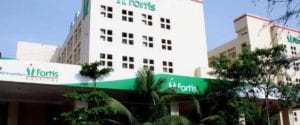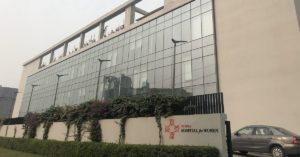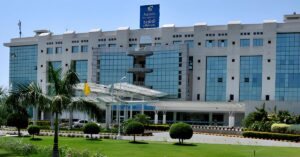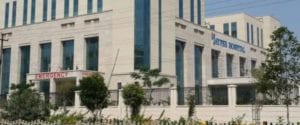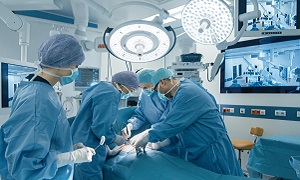Best Doctors in India for Tummy Tuck
Best Hospitals in India for Tummy Tuck
- City: Mumbai, India
Hospital Highlights:
- Fortis Hiranandani hospital was established in 2007.
- The hospital is an advanced tertiary care, multi-specialty hospital equipped with 149 beds.
- The hospital is equipped with a super ICU to provide emergency medical care to critically ill patients.
- The hospital is NABH accredited.
- The critical care facility in the hospital is augmented with the state-of-the-art facilities that facilitate speedier diagnosis and efficient monitoring.
- The hospital provides specialty medical services in cardiology, orthopedic science, pediatric science, neurology, diabetic care, urology, nephrology, ENT, obstetrics, gynecology, cosmetic surgery, bariatric surgery, neuro and spine care.
- City: Gurugram, India
Hospital Highlights:
- W Pratiksha Hospital, Gurugram, is one of the best hospitals in the NCR region. It is also a top hospital in India for IVF. Since its inception, the hospital has performed over 5500 successful IVFs. The hospital also specializes in gynecology.
- With over 20 years of experience in providing quality healthcare, the hospital is known as one of the most trusted and valued health providers in India.
- Equipped with world-class medical facilities and advanced technology, the hospital’s doctors and clinicians also have a track record of delivering excellent results. The hospital is also known for focusing on preventive well-being as much as on curative treatment.
- The hospital has earned the trust of its patients, by providing the best available treatments at affordable costs.
- City: Gurugram, India
Hospital Highlights:
- Paras hospital was established in 2006 and is the 250 bedded flagship hospital of Paras Healthcare.
- The is supported by a team of doctors of international and national repute.
- The hospital is NABH accredited and also the first hospital in the region to have a NABL accredited laboratory.
- The hospital provides specialty medical services in around 55 departments including Neurosciences, Joint Replacement, Mother & Child Care, Minimal Invasive Surgery, Gynecology and Obstetrics, Ophthalmology, Dermatology, Endocrinology, Rheumatology, Cosmetic and Plastic surgery.
- The hospital is equipped with state-of-the-art technologies.
- City: Kolkata, India
Hospital Highlights:
- Fortis Hospital, Anandapur, Kolkata is a world-class super-speciality equipped with the latest technologies in the medical world.
- The hospital is NABH accredited.
- This state-of-the-art facility specializes in cardiology and cardiac surgery, urology, nephrology, neurosciences, orthopaedics, digestive care, emergency care and critical care.
- The hospital, governed by integrated Building Management System (IBMS), has a pneumatic chute system, for quick vertical and horizontal transportation between floors, facilitating speedy transfer of patient specimens, documents, reports, and medicines to the concerned departments.
- The hospital also has a nephrology department with over 28 advanced dialysis units.
- City: Mumbai, India
Hospital Highlights:
- SL Raheja hospital is a 140-bed multi-specialty tertiary care hospital that is being managed by Fortis Healthcare Ltd.
- The hospital is a benchmark in healthcare and medical facilities in the neighborhood of Mahim & the western suburbs.
- L.Raheja Hospital, Mahim has one of the most effective ICU and Casualty care services.
- The hospital provides specialty medical services in Cardiology, Oncology, Neurology, Orthopedics, Mother & Child Care, and in Diabetes.
- City: Mumbai, India
Hospital Highlights:
- Wockhardt Hospitals were established in the year 1973, originally called First Hospitals and Heart Institute.
- Wockhardt Hospitals are super specialty health care networks in India, nurtured by Wockhardt Ltd, India’s 5th largest Pharmaceutical and Healthcare company.
- Wockhardt Hospitals is associated with Partners Harvard Medical International, an international arm of Harvard Medical School, USA.
- Wockhardt Heart Hospital performed India’s first endoscopic heart surgery.
- The hospital has a state-of-the-art infrastructure equipped with the latest technologies and modern equipment.
- It has special Centers of Excellence dedicated to the major specialties to provide hassle-free and high-quality clinical care.
- City: Gurugram, India
Hospital Highlights:
- The CK Birla Hospital in Gurugram is a NABH-accredited multi-specialty hospital.
- The hospital strives to increase the quality of healthcare by focusing on UK NHS nurse and midwife training requirements. Policies and practices derived from the National Institute for Health and Treatment Excellence (NICE) recommendations in the United Kingdom ensuring that a strong focus on safety, high-quality clinical care, and sanitation is maintained.
- The hospital’s cutting-edge technology and facilities allow for real-time communication and seamless collaboration among caregivers, ensuring accuracy and the best possible results. Those with foreign experience and accreditations make up part of the hospital’s team of clinicians.
- City: Ahmedabad
Hospital Highlights:
- As a member of the Apollo Hospitals Group, Apollo Hospitals International Limited, Ahmedabad is one of the most popular and sought-after medical facilities in Gujarat.
- Through its 6 Centres of Excellence and various affiliated branches, which cover all specialties and subspecialties, the hospital provides the most advanced clinical services.
- Since its inception in 2003, the hospital has been providing each patient with the most up-to-date medical equipment and state-of-the-art technology.
- With more than 150 successful organ transplants, including liver and renal transplants, the facility has been able to build a strong and extensive organ transplant program.
- In addition to performing 600 surgeries and caring for over 1800 patients on an IP basis, the hospital sees more than 18,000 patients on average in the outpatient department.
- With one of the biggest cardiology teams in the area, the hospital provides state-of-the-art regional care treatment in Cardiac Sciences.
- Additionally, the hospital offers a broad range of Neuro Interventional techniques to help stroke patients recover more quickly.
- City: Noida, India
Hospital Highlights:
- Jaypee Hospital is the flagship hospital of the Jaypee Group.
- This hospital has commissioned 525 beds in the first phase and has been planned and designed as a 1200 bedded multi-specialty facility.
- It holds the accreditation of the NABH and NABL.
- The hospital has state-of-the-art infrastructure equipped with the latest technologies and modern equipment like 64 Slice PET CT, Dual Head 6 Slice SPECT CT, Gamma Camera, and Da Vinci Robotic Surgery for comprehensive robotic surgical solutions.
- It has special Centers dedicated to the major specialties to provide hassle-free and high-quality clinical care.
- City: Mumbai, India
Hospital Highlights:
- Reliance Hospital is one of the best super-specialty care hospitals in Navi Mumbai.
- The main purpose of this hospital is to become a trustworthy place for the best health and hope for society. The hospital is well connected to the suburbs of Mumbai and Navi Mumbai.
- The hospital has various specialty departments, viz., Accident & Emergency, Anesthesiology, Dental Services, Dermatology, Diabetology, Dietetics Nutrition, Endocrinology, ENT, Gastroenterology, General Surgery, Gynaecology And Obstetrics, Hepato Pancreato Biliary Surgery, Infectious Disease, Internal Medicine, Interventional Radiology, Laboratory Medicine, Minimal Access Laparoscopic Surgery, Nephrology, Neurosciences, Opthalmology, Orthopaedics, Paediatrics, Pain Management Palliative Care, Physical Medicine Rehabilitation, Plastic And Reconstructive Surgery, Psychiatry, Pulmonary Medicine, Radiology, Rheumatology, Transplant, Urology Andrology, Vascular Surgery
Tummy Tuck
Tummy tuck also termed as abdominoplasty, is a cosmetic surgical procedure for flattening the abdomen by removing extra fat and skin; to improve its appearance. It tightens the walls in the abdominal area. Although it is different from liposuction, one can choose to get liposuction along with a tummy tuck.
You can choose to go for this procedure if you have excess fat or skin around the area of your belly button or a weak lower abdominal wall. A tummy tuck also helps to boost your body image.
Purpose
People can choose to go for a tummy tuck for a number of reasons. People with excess fat or poor skin elasticity or weakened connective tissue in the abdomen usually choose this procedure. These conditions are usually caused by significant changes in weight, pregnancy, abdominal surgery or aging.
Along with removing loose and excess skin and fat, it can also remove stretch marks and excess skin in the lower abdomen below the belly button. A tummy tuck however won’t be correcting any stretch marks outside of this area.
This procedure can also be combined with other contouring cosmetic procedures such as breast surgery. You can also consider this procedure after you have liposuction, as liposuction only removes the tissue under the skin and fat but not any excess skin.
It is to be noted that everyone isn’t the right candidate for a tummy tuck. Your doctor might caution against it if you are planning to lose a significant amount of weight, have a severe chronic condition, like diabetes or heart disease or if you have had a previous abdominal surgery which caused significant scar tissue.
Preparation
Initially, you will need to talk to a plastic surgeon about the procedure. A surgeon will likely:
Review your medical history- You will need to answer questions about your current and past medical conditions. You need to inform your surgeon if you are taking any medications or have taken any recently. Discuss any surgeries you have had as well.
Discuss your expectations- It is important to explain to your doctor why exactly you want a tummy tuck and what you hope for in terms of appearance after the procedure. Please make sure that you understand the benefits as well as the risks before the procedure. Also keep in mind that any previous abdominal surgery might limit your results as well.
Do a physical exam- To determine your treatment options, your doctor will need to examine your abdomen. He/she might also need to take pictures of the abdomen for your medical record.
Before undergoing the procedure you also need to:
Stop smoking- Smoking decreases blood flow in the skin, thus, slowing down the healing process. It also increases the risk of tissue damage. Therefore, if you smoke, your doctor might recommend that you stop doing so before your surgery and during the recovery period.
Avoid certain medications- Few medications such as aspirin, herbal supplements and anti-inflammatory drugs will need to be avoided.
Maintain a stable weight- Ideally it is important to maintain a stable weight for at least 12 months before having a tummy tuck. If you are overweight, you will need to lose weight before this procedure. Any weight loss after the procedure might diminish the results.
Take medication to prevent complications- Shortly before the procedure, you’ll need to begin taking an anticoagulant for preventing blood clotting.
Arrange for help during recovery- Make plans with someone for driving you home after you leave your hospital and ask if they can stay with you for at least the first night of your recovery at home.
A tummy tuck is usually done in a hospital or sometimes at an outpatient surgical facility. During the procedure, you will be under general anesthesia, which will make you totally unconscious and unable to feel any pain. Sometimes, you also might be given a pain-relieving medication and be moderately sedated.
Procedure
The procedure can take from two to five hours depending on the technique being used.
With a complete tummy tuck, your surgeon will first make two incisions. The first one will be from the hip bone on one side to the hip bone on the other side of the body, which is near the public area. The other incision will be around the navel.
If you are having a partial tummy tuck, your surgeon will be making one or two smaller incisions. This can be done laparoscopically or via an open procedure.
Once the incisions are made, the skin is separated from the abdominal muscles. Excess fat is removed from the abdominal area.
If they are separated, the abdominal muscles might need to be pulled together and stitched into place. Then the separated flap of skin is stretched over the abdominal area; after this, excess skin is removed for a tighter appearance. If your surgeon included the navel in the incisions, it is reconstructed in a position where it can look natural.
Sometimes, a surgical drain might be inserted under the skin for collecting any excess fluid. This will be staying in place for many weeks before its removal. Next, the incisions are closed with sutures. A sterile dressing is then applied over the area as well.
After the procedure
Once the procedure is complete, your anesthesia is removed or reversed. If you have a tube in place to help you breathe, this will be removed so that you can breathe on your own before leaving the operating room.
Next, you will be taken to a post-operative area where your vital signs will be monitored. It will several hours before you will be able to get up and walk again. Generally, you can go home or stay in the hospital according to your plan prior to the surgery.
Recovery from any type of tummy tuck can take two weeks to two months. Generally, if you have a large wound and/or a significant amount of fat and skin removed, then your recovery will take longer, as compared to when you have a small wound and a smaller amount of tissue removed.
Risks
There are multiple risks and complications which are associated with the tummy tuck procedure. Some of the risks include:
- Swelling and pain around the surgery area
- Scarring
- Skin discoloration
- Seroma (fluid accumulation)
- Changes in skin sensation
- Bleeding under the skin flap (rare)
Before the procedure, it is always important that you discuss the possible risks with your surgeon.

